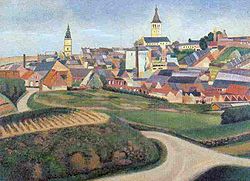
Auguste Herbin
Encyclopedia

France
The French Republic , The French Republic , The French Republic , (commonly known as France , is a unitary semi-presidential republic in Western Europe with several overseas territories and islands located on other continents and in the Indian, Pacific, and Atlantic oceans. Metropolitan France...
painter
Painting
Painting is the practice of applying paint, pigment, color or other medium to a surface . The application of the medium is commonly applied to the base with a brush but other objects can be used. In art, the term painting describes both the act and the result of the action. However, painting is...
.
Biography
Born in QuiévyQuiévy
-References:*...
, Nord, he studied drawing at the École des Beaux-Arts de Lille, from 1898 to 1901, when he settled in Paris
Paris
Paris is the capital and largest city in France, situated on the river Seine, in northern France, at the heart of the Île-de-France region...
.
The initial influence of Impressionism
Impressionism
Impressionism was a 19th-century art movement that originated with a group of Paris-based artists whose independent exhibitions brought them to prominence during the 1870s and 1880s...
and Post-Impressionism
Post-Impressionism
Post-Impressionism is the term coined by the British artist and art critic Roger Fry in 1910 to describe the development of French art since Manet. Fry used the term when he organized the 1910 exhibition Manet and Post-Impressionism...
visible in paintings that he sent to the Salon des Indépendants
Société des Artistes Indépendants
—The Société des Artistes Indépendants formed in Paris in summer 1884 choosing the device "No jury nor awards" . Albert Dubois-Pillet, Odilon Redon, Georges Seurat and Paul Signac were among its founders...
in 1906 gradually gave way to an involvement with Cubism
Cubism
Cubism was a 20th century avant-garde art movement, pioneered by Pablo Picasso and Georges Braque, that revolutionized European painting and sculpture, and inspired related movements in music, literature and architecture...
after his move in 1909 to the Bateau-Lavoir
Le Bateau-Lavoir
Le Bateau-Lavoir is a name which French painter Max Jacob coined for an area at the top of the steps leading to No. 13 Rue Ravigan, in Montmartre, Paris . The area is famous in art history because around the start of the 20th century a group of outstanding artists lived and rented artistic studios...
studios, where he met Pablo Picasso
Pablo Picasso
Pablo Diego José Francisco de Paula Juan Nepomuceno María de los Remedios Cipriano de la Santísima Trinidad Ruiz y Picasso known as Pablo Ruiz Picasso was a Spanish expatriate painter, sculptor, printmaker, ceramicist, and stage designer, one of the greatest and most influential artists of the...
, Georges Braque
Georges Braque
Georges Braque[p] was a major 20th century French painter and sculptor who, along with Pablo Picasso, developed the art style known as Cubism.-Early Life:...
and Juan Gris
Juan Gris
José Victoriano González-Pérez , better known as Juan Gris, was a Spanish painter and sculptor who lived and worked in France most of his life...
; he was also encouraged by his friendship with Wilhelm Uhde
Wilhelm Uhde
Wilhelm Uhde was a German art collector, dealer, author and critic, an early collector of modernist painting, and a significant figure in the career of Henri Rousseau.-Biography:...
. His work was exhibited in the same room as that of Jean Metzinger
Jean Metzinger
Jean Metzinger was a French painter.Metzinger was born in Nantes, France. Initially he was influenced by Fauvism and Impressionism, but from 1908 he was associated with Cubism. Metzinger was a member of the Section d'Or group of artists...
, Albert Gleizes
Albert Gleizes
Albert Gleizes , was a French painter. Born Albert Léon Gleizes and raised in Paris, he was the son of a fabric designer who ran a large industrial design workshop...
and Fernand Léger
Fernand Léger
Joseph Fernand Henri Léger was a French painter, sculptor, and filmmaker. In his early works he created a personal form of Cubism which he gradually modified into a more figurative, populist style...
in the Salon des Indépendants of 1910, and in 1912 he participated in the influential Section d'Or
Section d'Or
The Section d'Or , also known as Groupe de Puteaux or Puteaux Group, was a collective of painters and critics associated with an offshoot of Cubism known as Orphism...
exhibition.
After producing his first abstract paintings in 1917, Herbin came to the attention of Léonce Rosenberg who, after World War I
World War I
World War I , which was predominantly called the World War or the Great War from its occurrence until 1939, and the First World War or World War I thereafter, was a major war centred in Europe that began on 28 July 1914 and lasted until 11 November 1918...
, made him part of the group centred on his Galerie de l'Effort Moderne and exhibited his work there on several occasions in 1918 and 1921. Herbin's radical reliefs of simple geometric forms in painted wood, such as Coloured Wood Relief (1921; Paris, Musée National d'Art Moderne
Centre Georges Pompidou
Centre Georges Pompidou is a complex in the Beaubourg area of the 4th arrondissement of Paris, near Les Halles, rue Montorgueil and the Marais...
), challenged not only the status of the easel painting but also traditional figure–ground relationships. The incomprehension that greeted these reliefs and related furniture designs, even from those critics most favourably disposed towards Cubism, was such that until 1926 or 1927 he followed Rosenberg's advice to return to a representational style. Herbin himself later disowned landscapes, still lifes and genre scenes of this period, such as Bowls Players (1923; Paris, Musée National d'Art Moderne), in which the objects were depicted as schematized volumes.
He died in Paris.

